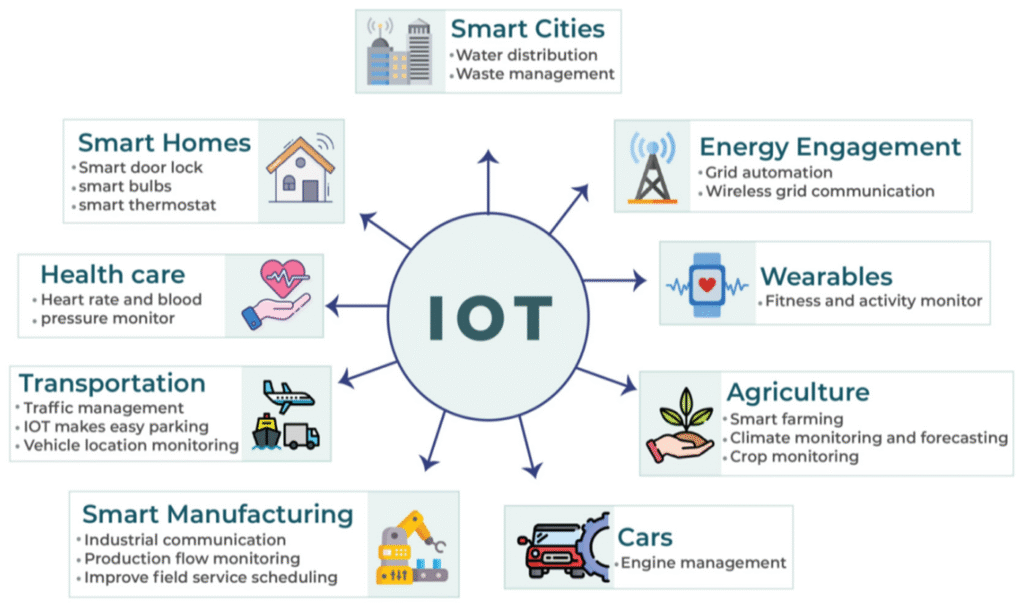Introduction
IoT Picture this: Traffic lights that change based on real-time traffic. Streetlights that brighten only when needed. Trash cans that alert workers when full. This is the magic of IoT (Internet of Things) in smart cities.
Additionally, cities worldwide are using it to save money, reduce pollution, and make life easier. Furthermore, how does it all work? Let’s break it down in simple terms.
IoT Here’s what we’ll cover:
- Firstly, how does it make cities smarter
- Secondly, the tech behind the scenes
- Thirdly, real examples of smart cities
- Fourthly, problems and future changes
- Then, quick answers to common questions

How IoT Helps Cities Run Better
1. IoT Smarter Traffic Control
Stuck in traffic? It helps fix that. Sensors monitor cars and adjust signals to keep traffic flowing.
Example: In some cities, lights change faster when roads are packed. This cuts down on jams.
2. Less Wasted Energy
Moreover, lights, power, and water cost money. IoT helps cities use less.
How?
- Streetlights dim when no one’s around.
- Smart water meters find leaks fast.
3. Safer Streets
Furthermore, IoT keeps people safe with:
- Cameras that spot accidents or crimes.
- Systems that call police or ambulances faster.
The Tech That Makes IoT Work
1. Tiny Sensors Everywhere
Firstly, these small devices track things like air quality, noise, and movement.
2. Faster Internet (5G)
Secondly, quick data transfer means devices talk to each other instantly. This is key for self-driving cars and emergency alerts.
3. AI That Learns
Thirdly, Artificial intelligence studies traffic patterns, energy use, and more to make smart choices.
4. Blockchain for Safety
This keeps data secure, so hackers can’t mess with traffic signals or power grids.
Real Cities Using IoT Right Now
1. Barcelona, Spain
- Firstly, smart streetlights save 30% on energy.
- Secondly, parking apps help drivers find spots fast.
2. Singapore
- Firstly, Self-driving buses run on schedule.
- Smart trash bins tell crews when to empty them.
3. Copenhagen, Denmark
- Firstly, uses it to cut carbon emissions.
- Track bikes to build better lanes.
IoT Problems and What’s Next
1. Keeping Data Safe
More sensors mean more hacking risks. Moreover, cities must protect information.
2. High Costs
Smart tech isn’t cheap, but it saves money long-term.
3. Coming Soon
- Firstly, More self-driving cars and buses.
- Virtual city copies (“digital twins”) to test ideas.
- Doctors are monitoring patients from afar.
IoT Quick Questions & Answers
1. What’s a smart city?
A city that uses tech to improve life—less traffic, cleaner air, lower bills.
2. How does IoT fix traffic?
Sensors watch cars and adjust lights. Apps suggest faster routes.
3. Are smart cities safe from hackers?
Mostly, but security keeps improving.
4. Which cities are the smartest?
Barcelona, Singapore, and Copenhagen lead the way.
5. Will robots take over city jobs?
No, tech helps workers do their jobs better.
IoT The Bottom Line
Finally, it is changing cities for the better. Less traffic. Cleaner air. Lower costs. But we need strong security and smart spending to make it work.
The future looks bright and smart! What tech would you like to see in your city?
Key Points to Remember
Firstly, it helps cities save money and energy.
Secondly, sensors, 5G, and AI make it all possible.
Thirdly, Barcelona and Singapore are great examples.
Fourthly, security and cost are big challenges.
Then, self-driving cars and virtual cities are coming soon.
Would you like smart tech in your town? Share your thoughts below! 😊
